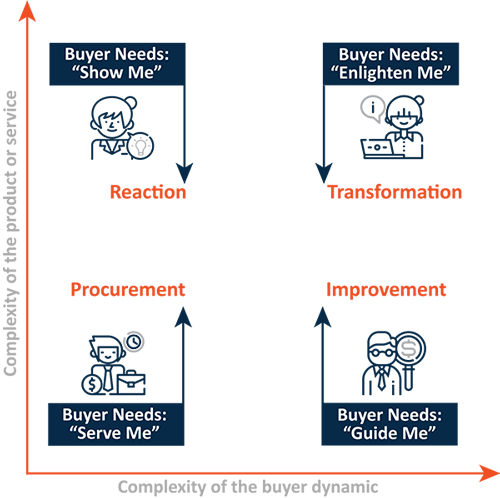Buyer personas are semi-fictional representations of your ideal customer created by using market research and real data about your existing customers. There are various approaches to persona development but most include customer demographics, behavior patterns, motivations, and goals. Buyer personas have long been the foundation for marketing strategy development.
The challenge most often faced is that properly creating buyer personas takes a lot of effort and time. Companies who are successful at creating strong and meaningful personas typically do the following:
- Analyze their closed opportunities
- Conduct customer interviews and focus groups beyond their customer base
- Purchase industry reports related to their industry
Most organizations aren’t willing (or don’t have the resources) to truly go through the exercise of persona development. However, when persona based marketing became the latest buzz word, most marketing organizations set out to do the best they could with creating personas, in many cases, relying on the assumptions and hypotheses of their sales organization.
Personas are meant to be the foundation for all of your marketing efforts. At one of my former places of employment, we started the persona process and created a primary persona (used focus groups, involved a strategic partner, the whole 9 yards). In the end, we only completed one. To complete the others, we made assumptions based on our experience. This is the challenge that most organizations face. If personas are only mediocrely defined, how can we expect to achieve exceptional results? I have always felt like there had to be an effective alternative, and I’m happy to report that there is a way!
JOURNEY ARCHETYPES
Lori Wizdo at Forrester Research has defined four journey archetypes that you can use that can serve as the foundation of your marketing efforts and help you understand your buyers. These archetypes, also known as the four motivations for making a purchase, are procurement, improvement, reaction, and transformation. Unlike personas, which focus on the individual’s role within the organization, the journey archetypes focus more on why a buyer is in the market for your solution. These archetypes are plotted on x-y chart with product or service complexity plotted against the ease/difficulty of the sales process.
Procurement – The Procurement Archetype knows what they want.
- Your solution is likely already a line item in their budget and their team probably has experience with products and services like yours.
- Your job as a marketer is to validate that you can meet their requirements, and that your organization is one they want to do business with.
- These buyers, in their early stage, will function a lot like later stage buyers. They are less interested in thought leadership content and more interested in the specifics of your solution.
- An example of the Procurement Archetype is an organization who has been using another marketing automation platform for several years and is now migrating to Eloqua or Responsys.
Improvement – The Improvement Archetype is looking to improve upon something they are doing now but they are not fully aware of the steps to take.
- They don’t know what they don’t know so they need guidance on what the best solution is to meet their needs. They may or may not have budget allocated for the purchase and their team likely only has a basic understanding of what you offer.
- Your job is to help them navigate the options, identify key considerations, and help them make the best choice for their business. Buyers seeking improvement need content that helps them make the right decision.
- Like Procurement buyers, they will be less interested in thought leadership content and more interested in tools and resources for evaluating the right solution.
- An example of the Improvement Archetype is an organization that is currently using a basic email tool that only allows them to do batch and blast communications but they are interested in purchasing Eloqua or Responsys to improve their marketing strategy and increase efficiency.
Reaction – The Reaction Archetype is the “oh crap” buyer. They are making a purchase that is a reaction to something that has happened in their business or their industry.
- These buyers do not have a budget planned for your solution and they are unsure of what their needs are. They are simply reacting to an event that has significantly impacted them.
- Your job is to show them how to avoid or fix whatever they are reacting to. These buyers care less about the details and more about the assurance that you can help.
- Reaction buyers are interested in industry studies and thought leadership pieces that help them understand what they are missing. They also care about how quickly they can begin seeing value from their purchase.
- An example of the Reaction Archetype is a company that wants to implement data security protocols because they (or a competitor) just had a security breach.
Transformation – The Transformation Archetype needs support to fully change their business. These are the most complex clients.
- They don’t know what they don’t know and look to you as the expert to figure it all out. They often don’t have budget aligned to the initiative and will need support justifying the expense.
- The buying journey for the Transformation Archetype is typically the longest. These buyers are interested in all types of content. The more information you can provide to help them in their decision process, the better.
- An example of the Transformation Archetype is a company with multiple disparate systems and a lot of manual processes. They want to improve data quality and efficiency, but they don’t know what is required to get there.
GETTING STARTED
You now have the foundational building blocks to begin the journey mapping process. If your organization is further along in its Modern Marketing Journey and you have well defined personas, marrying those personas (the ‘who’) with the Journey Archetype (the ‘why’) puts you ahead of the curve. If you haven’t built effective personas, the Journey Archetypes are a great way to begin building your buyers journeys.
Before you begin the process of defining the relevant stages in the buyer journey, I urge you to spend some time as a team to discuss the archetypes and how they apply to your prospects and customers. The process of becoming ‘Journey Marketers’ is a fun one for your marketing team if you hit the ground running with all the right information and tools.
I’d love to talk to you more about the journey process and the different journey archetypes, and how to leverage this method for your business. Our Strategists can help you understand how the Journey Archetypes can be used with or without Buyer Personas, how the archetypes align to your products and solutions, and define the journey and map your content.
About the Author
Follow on Twitter Follow on Linkedin Visit Website More Content by Brandi Starr














